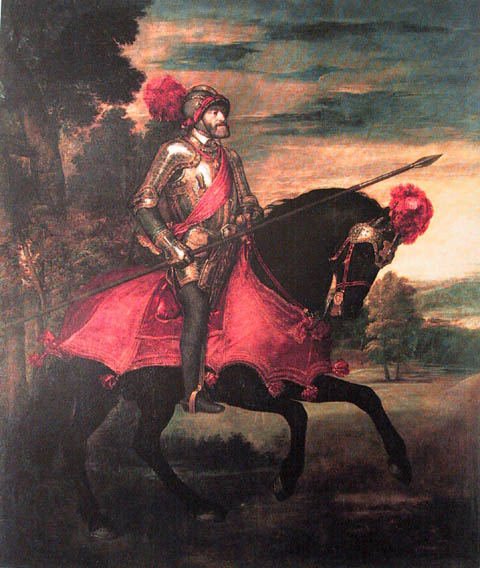
Charles V (1500-1558)
Seven rulers of the Holy Roman Empire were named Charles. The first was Charlemagne, the founder of the empire, whose name means "Charles the Great." Of the other six, Charles V is especially notable for his widespread holdings and eventful reign.

Charles's territories stretched across most of Europe—except for England, France, and Russia—and into the Americas. For decades he defended them tirelessly. Yet at 56 he voluntarily gave up his vast realm and retired to spend his last days in a Spanish monastery.
Charles was born on Feb. 24, 1500, at Ghent in the Netherlands (now Belgium). His father was Philip of Hapsburg, whose own father was Maximilian, archduke of Austria and Holy Roman emperor. Charles's mother was Joan the Mad, daughter of Ferdinand and Isabella, king and queen of Spain. Charles was raised in the Netherlands. His father died in 1506, bequeathing to him the kingdoms of Castile and the Netherlands. With the death of his grandfather Ferdinand 10 years later, Charles gained control of the rest of Spain—and of Spain's colonies in the New World—as Charles I. He also became king of Sicily and Naples. In 1517 he went to Spain for the first time to set up a court at Valladolid. In 1519 his grandfather Maximilian died, leaving him the German Hapsburg realms. Shortly afterward, in a vote of nobles, he was elected Holy Roman emperor as well, though he was not actually crowned until later.
Charles's chief rival for power in Europe was Francis I of France, who had wanted to be emperor himself. The French king claimed Charles's possessions in Italy. Between 1522 and 1544, Spanish armies defeated French forces three times before Francis gave up his claim.
Muslim forces posed another threat. The armies of Suleyman the Magnificent, sultan of the Ottoman Turks, pressed up the Danube River into central Europe. Charles led a defense of Vienna in 1532 and later sailed to northern Africa to fight the Muslim pirates who raided his coast towns in Spain and Italy.
Across the Atlantic Ocean, Charles's Spanish armies were conquering the rich empires of Mexico and Peru. In the 1550s, late in Charles's reign, gold and silver were brought back from the New World in large quantities.
Charles was a devoted Roman Catholic but was unable to stop the great religious and social revolution, called the Reformation, that was started by the German monk Martin Luther. Luther's efforts to reform the Catholic church led to the establishment of Protestant forms of Christianity, including Lutheranism. Charles defeated a group of Protestant princes at Mühlberg in April 1547, but only eight years later he was forced to allow the Peace of Augsburg, which acknowledged the legitimacy of Lutheranism within the Holy Roman Empire.
Charles had great military skill, which he demonstrated in both land warfare and naval expeditions. He also had great courage. Once when his aides rebuked him for exposing himself to danger, he replied, "We were short of men, and I could not set a bad example."
In intervals of peace, he turned to forming alliances through royal marriages in order to stabilize his realm. He married Isabella, the daughter of the king of Portugal. He also arranged for his sister Mary to marry the king of Hungary, his brother Ferdinand to marry the sister of the Hungarian king, and his son Philip to marry the English queen Mary I. The last marriage failed to further Charles's cause as the English Parliament refused to crown a Catholic king.
Tired by his long and tumultuous reign, Charles abdicated in 1555 and 1556, dividing his realm between his son Philip and his brother Ferdinand. Charles kept the title of Holy Roman emperor until his death but did not use its power. He retired to a small home adjoining St. Jerome's monastery at Yuste, where he died on Sept. 21, 1558. (Encyclopaedia Britannica Article)